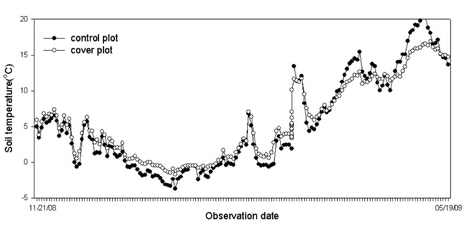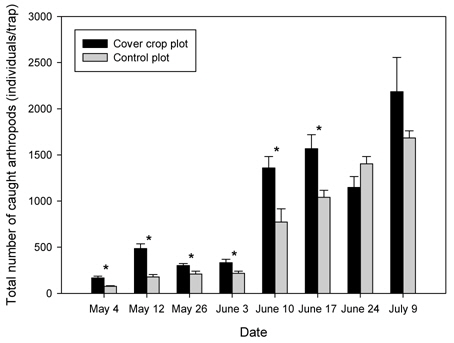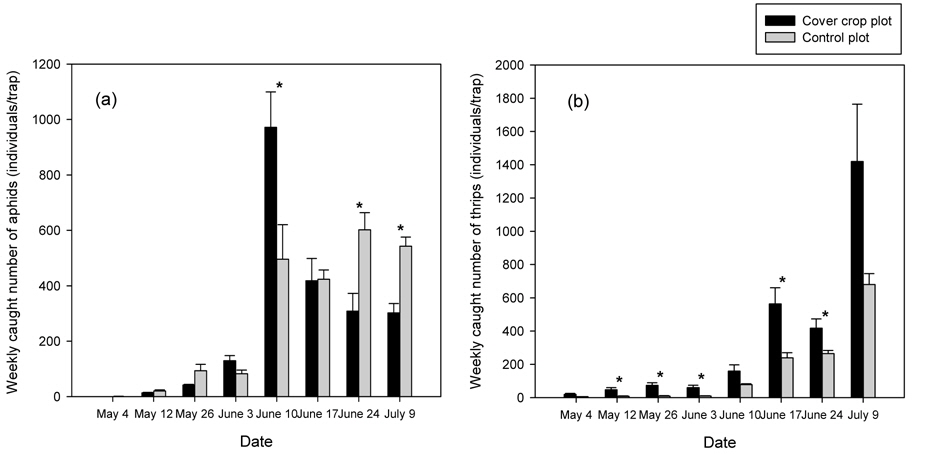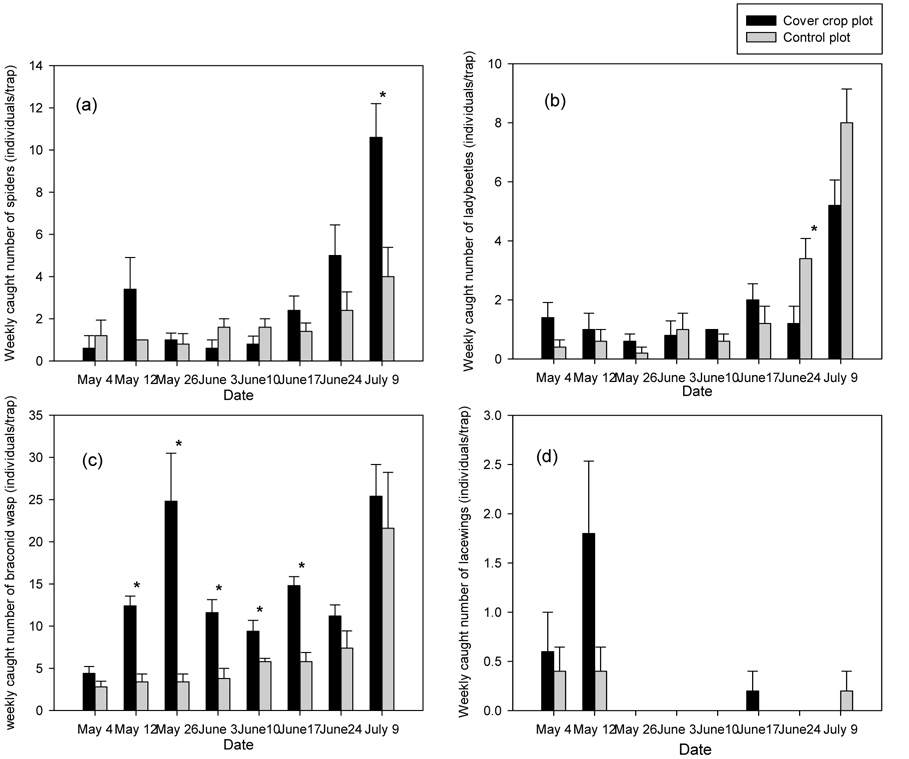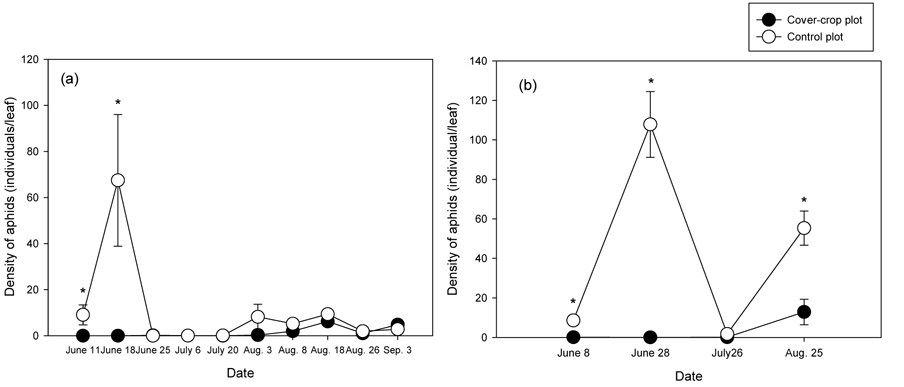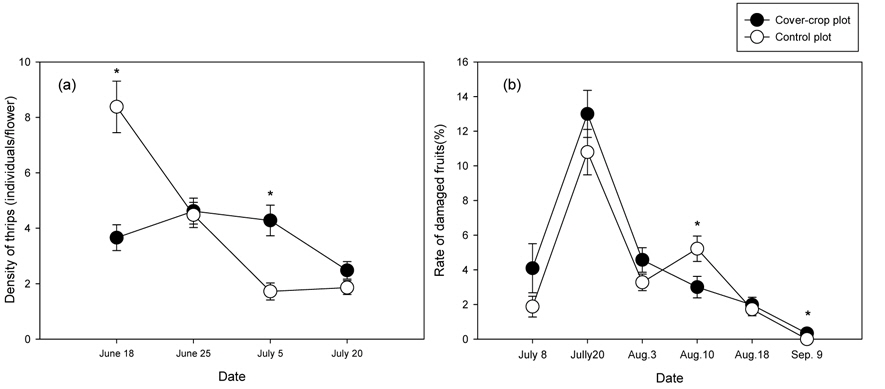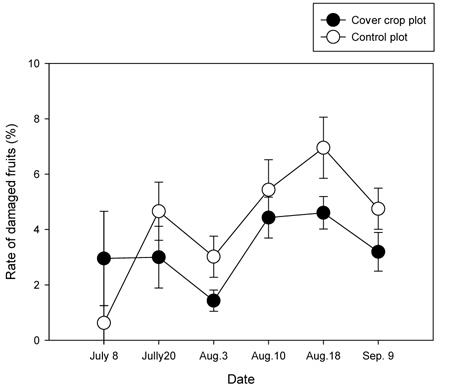



In organic agriculture, various cover crops have been used to control weeds. In this study, we investigated the suppressive effects of
To estimate the effect of cover-crop on arthropod diversities and occurrences of insect pest in pepper.
Populations of aphids, thrips and braconid wasps were maintained high on
유기농업은 농업생태계의 건강증진, 생물 종의 다양성 유지, 생물순환 및 생물활동 증진을 위한 총체적 농업체계로 정의된다(Jee
세계적으로 안전성과 건강을 중요시 하는 농산물 소비패턴의 변화와 지속가능한 농업의 필요성 증가로 유기농업의 수요가 최근 급격히 증가하고 있다(IFOAM, 2011). 국내에서도 지난 10년간 유기농업 생산면적은 19,312ha 까지 증가하여 2010년에는 전체 농가에 대한 유기재배 농가의 비율이 0.9%에 이르렀다(Kim
이에 따라 유기농산물을 안정적으로 생산하기 위한 친환경적 농작물 재배기술의 요구가 증가하고 있다. 현재 식물추출물, 해충 병원성 미생물, 천적, 해충 유살트랩 등의 기술개발이 꾸준히 이루어지고 있으며, 특히 고삼, 제충국, 멀구슬나무 등의 식물추출물은 진딧물(Kim
그러나 유기농업은 생태계와 물질 순환을 바탕으로 생태계 안에서 모방하고 유지하도록 해야 한다는 유기농업 생태의 원칙(Luttikholt, 2007)에 적합한 생태적 해충관리 방법에 대한 연구결과는 상대적으로 부족한 실정이다.
최근 농업생태계의 생물다양성을 증진시키기 위하여 피복작물, 동반 작물을 작물과 함께 심거나, 다양한 작물을 혼작, 윤작하는 연구가 활발하게 진행되고 있다. 특히 농경지 내 피복식물 또는 동반작물을 재배하는 등의 농업생태계 식생다양성 증가에 따른 곤충 개체군 및 군집상의 변화에 대한 연구가 국내외에서 보고되고 있다. 단일작물을 재배하는 경우 보다 여러 작물을 재배하였을 때 천적의 밀도가 훨씬 더 높다는 연구결과가 있다(Andow, 1991; Landis
국내에서는 고추 재배 시 잡초방제의 목적으로 얼치기완두등 나비나물속의 피복식물이 선발되었다(Cho
본 시험은 경기도 수원시 망포동에 위치한 포장에서 얼치기완두 피복처리구와 대조처리구로 구분하여 수행하였다. 얼치기완두 피복처리구는 2008년과 2009년 10월 파종하여 월동 후 이듬해에 얼치기완두로 피복된 지표면에 무경운 상태로 고추를 정식하였다. 대조구는 비닐피복처리구로서, 동절기에는 무피복 상태로 유지하였으며, 고추 정식 시 경운 후 흑색비닐로 피복하였다. 고추는 2009년에는 5월 19일에, 2010년에는 5월 20일에 각각 정식하였다.
고추 정식 전, 후의 곤충상 변화를 처리구 간에 비교하기 위하여, 황색점착트랩(10 cm*14.8cm)을 얼치기완두 피복 포장과 대조구 포장에 지상으로부터 50 cm 위치에 5개씩 설치하고 7일 간격으로 교체하였다. 황색점착트랩에 채집된 곤충은 실내에서 실체현미경을 이용하여 동정하였다.
고추 주요 해충 발생 및 피해조사
고추 정식 이후 고추 주요해충인 진딧물, 총채벌레의 밀도와 담배나방, 총채벌레에 의한 피해과율을 조사하였다. 진딧물의 밀도는 상⋅중⋅하엽 각 1엽씩 선발하여 총 개체수를 세었다. 2009년에는 6월 11일부터 9월 3일까지 2주 간격으로 10회에 걸쳐 조사하였으며, 2010년에는 6월 8일부터 8월 25일까지 4회에 걸쳐 조사하였다. 총채벌레는 주로 꽃에 분포하여 과실에 피해를 주는 해충이므로 꽃을 수거하여 총채벌레의 밀도를 조사하였다. 꽃이 피기 시작하는 7월 8일부터 8월18일까지 7일 간격으로 처리 당 100개의 꽃을 채집하였으며, 채집 과정에서 총채벌레의 유실을 막기 위하여 에틸 알콜이든 20 ml 유리병을 꽃 바로 아래 받힌 후 손으로 꽃을 절단하여 채집하였다. 채집된 꽃에 존재하는 총채벌레의 밀도는 실체현미경으로 조사하였다.
고추 과실이 달리기 시작하는 7월 6일부터 9월 3일까지 7일 간격으로 담배나방 및 총채벌레 피해과율을 조사하였다. 피해과수는 주당 피해 받은 과수를 10주씩 4반복으로 조사하였다. 피해과율은 피해 받은 과수에 총과수를 나누는 방법으로 계산하였다.
처리간의 차이를 비교하기 위하여 조사된 자료는 T-test를 이용하여 P <0.05의 범위에서 유의성을 검정하였다(SAS institute, 2006).
절지동물은 얼치기완두 피복 처리구에서 총 37,721 개체가 채집되었고 대조구에서는 총 27,899 개체가 채집되었다. 두 처리구에서 노린재목과 파리목이 가장 많이 채집되었으나, 처리간의 유의한 차이는 보이지 않았다(노린재목, P= 0.7539; 파리목,
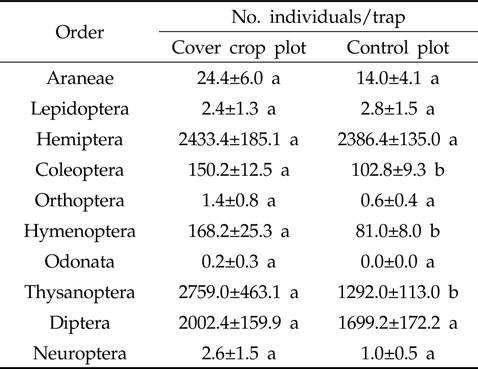
Occurrence of arthropods caught by yellow stick traps in cover crop, Vicia tetrasperma, and control plots in 2009
고추 정식 전, 후 황색점착트랩에 채집된 고추 주요 해충의 개체수를 비교한 결과, 진딧물 유시충이 고추 정식 직후에는 얼치기완두 피복처리구에서 유의하게 높은 결과를 보였으나, 고추가 생장하면서 대조구에서 진딧물 유시충이 더 많이 유인되는 것으로 조사되었다(Fig. 3(a)). 한편 총채벌레류는 조사 전 기간에 걸쳐 얼치기완두 피복처리구에서 높게 발생하는 것으로 조사되었다(Fig. 3(b)). 총채벌레 특히 꽃노랑총채벌레와 대만총채벌레는 vicia 속 식물이 기주범위에 속하므로(Buggs, 1991) 얼치기완두 피복재배는 총채벌레 류의 서식처로 제공되어 높은 밀도를 보인 것으로 생각된다.
주요 천적군인 거미, 무당벌레, 고치벌, 풀잠자리의 시기별 변동을 비교해 본 결과, 거미의 경우 유의한 차이를 보이지 않다가 7월 9일 얼치기완두처리구에서 거미의 발생이 유의하게 높은 것으로 조사되었다(Fig. 4(a)). 무당벌레의 경우 두 처리구 모두 비슷한 경향을 보였으나, 고추 정식 이후 얼치기 완두 처리구에서 무당벌레의 밀도가 급증하는 경향을 보였다 (Fig. 4(b)). 무당벌레는 이동성이 높은 천적으로, 진딧물의 밀도에 따라 군집을 형성하는 특성을 가지고 있어(Ives
주목할 점은 진딧물 및 담배나방의 천적이 속해있는 고치벌류는 얼치기완두 피복처리구에서 전 기간에 걸쳐 상당히 높은 밀도를 형성하고 있는 것으로 조사되었다(Fig. 4(c)). 이러한 결과는 우선 초봄 고치벌의 먹이곤충의 밀도가 나지 상태의 대조구 보다 얼치기완두 피복처리구에서 더 높아 고치벌의 증식을 증가시켰을 것으로 생각된다. 조사가 시작된 5월초 얼치기완두가 개화하여 고치벌 성충에게 꿀, 화분 등 을 공급하여 고치벌류의 밀도 형성에 영향을 주었을 것으로 생각된다. 먹이 곤충 이외에 식물 꿀, 화분 등의 공급은 고치벌류 성충에게 수명 증가 뿐 만 아니라 산란수 증가, 이동성 증가 등 긍정적인 영향을 주는 것으로 보고되어 있다 (Hagley and Barber,1992; Daggen and Gurr, 1998). 풀잠자리류는 두 처리구 모두에서 낮은 수의 개체가 채집되었으며 처리간에 유의한 차이는 없었다(Fig. 4(d)).
2년 동안의 처리구별 진딧물 발생양상은 비슷한 경향을 보였다(Fig. 5). 고추 생육 초기를 제외하고 전체적으로 진딧물의 발생이 적었으며, 감자수염진딧물, 목화진딧물, 복숭아 혹진딧물 등 3종이 발생하였다. 고추 생육 초기에 얼치기완두 피복처리구에서 진딧물이 거의 발생하지 않은데 비하여 겨울동안 나지상태로 유지되다가 고추 정식 시 비닐피복 처리한 대조구에서는 2008년에는 잎당 60마리 이상의 진딧물이 발생하였으며, 2009년에는 잎당 100마리 이상의 진딧물이 발생하였다. 반면 얼치기완두 피복은 초기 진딧물 밀도 증가를 유의하게 억제하는 결과를 보였다. 이러한 양상은 화이트클로버, 레드클로버를 피복재배한 브로콜리에서 복숭아혹진딧물 밀도가 유의하게 낮았던 Costello 와 Altieri(1995)의 결과와 유사하였다. 고추에서 피해를 주는 오이모자이크바이러스(CMV), 고추모틀바이러스(PepMoV), 토마토모자이크바이러스(ToMV), 잠두위조바이러스(BBWV) 등의 바이러스병은 진딧물에 의해 매개되는 것으로 알려져 있다(Lee
고추 정식 이후부터 7월 중순까지 꽃 수거를 통하여 총채벌레 밀도 변화를 조사하였다. 6월 18일 조사 시 꽃 당 총채벌레의 밀도는 대조구에서 얼치기완두 피복처리구 보다 유의 하게 높은 경향을 보였으나(Fig. 6(A)), 시간이 지남에 따라 대조구에서 총채벌레의 밀도는 감소하였다. 반면 얼치기완두 피복처리구에서는 총채벌레의 밀도가 일정한 경향을 보여 7월 초에는 얼치기완두 피복처리구에서 총채벌레의 밀도가 대초처리구보다 유의하게 높았다(Fig. 6(a)). 그러나 총채벌레에 의한 고추 피해과율은 얼치기완두 처리구에서 전반적으로 다소 높게 나타났으나 처리간의 유의성은 없었다(Fig. 6(b)).
고추의 주요 해충인 꽃노랑총채벌레는 복숭아 과수원에서 지상 1m 까지 활발하게 이동하고 2m 높이에 설치된 점착트랩에서 채집이 된다고 보고되어 있어(Pearsall, 2001), 얼치기완두에서 증식된 총채벌레가 고추로 이동할 가능성이 높다. 얼치기완두와 고추 간의 총채벌레 이동양상 및 기주선호성에 대한 평가가 이루어 져야 할 것으로 생각된다.
담배나방의 피해과율은 두 처리구 모두에서 8% 미만으로 낮게 발생했으며 고추 생육 초기를 제외하고 대조구에서 담배나방에 의한 피해과율이 더 높은 것으로 조사되었으나 통계적인 유의성은 없었다(Fig. 7).
본 연구 결과를 통하여 얼치기완두 피복처리구와 대조구에서 절지동물 발생 및 주요 해충 발생 양상이 다름을 알 수 있었다. 또한 얼치기완두 피복은 고추 재배 초기 진딧물 억제에 탁월한 것으로 조사되었다. 이러한 기술은 유기농업에서 노지고추 재배 시 진딧물 예방을 위해 활용될 수 있는 기술로 생각된다. 하지만 얼치기완두는 국내 자생 잡초로 종자의 상업적 유통이 이루어지지 않아, 종자의 수급이 어렵다는 단점이 있어 얼치기완두 이외에 쉽게 농가에서 구입할 수 있는 피복식물 자원에 대한 추가적인 검토가 필요하다. 또한 얼치기 완두 피복재배시 절지동물상 특히 천적의 발생과 진딧물 억제 간의 상호작용 기작과 총채벌레의 얼치기완두와 고추 사이의 이동 및 행동반응에 대한 추가적인 연구가 필요하다.


